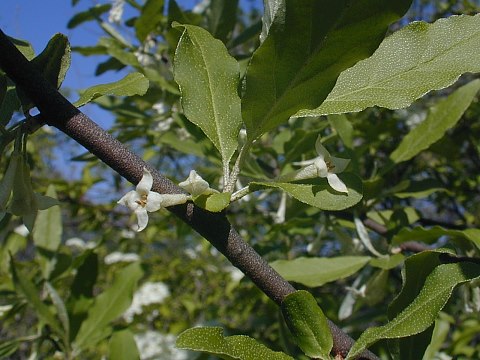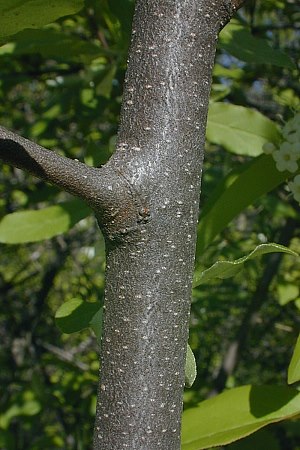Description: This is a woody shrub about 10-20' tall that branches frequently; it is usually a little taller than wide. The central trunk on mature shrubs (if any) is short; it has gray bark that is split and furrowed. The bark of medium to large branches, in contrast, is gray-brown and relatively smooth. Young branches are silvery green to brown and covered with small scales. The alternate leaves are up to 3" long and 1¼" across; they are elliptic-oblong to ovate with smooth margins, blunt tips, and wedge-shaped to rounded bottoms. The upper surface of each leaf is light to medium green and slightly scaly; the lower surface is whitish green to white and densely covered with small silvery scales. The petiole of each leaf is relatively short and densely covered with silvery scales. Scales on the young branches, leaves, and petioles may turn brown with age. From the axils of the leaves, there develops small umbels of 1-4 flowers. Each flower has a tubular calyx about ½" long that is white or cream-colored and trumpet-shaped. This corolla-like calyx has 4 spreading lobes that are shorter than its tubular base. In addition to the calyx, each flower has 4 stamens, a single style, and no petals (nor true corolla). The short pedicel of each flower is up to ¼" long and covered with silvery scales. The blooming period occurs from late spring to early summer. The flowers have a sweet fragrance that is quite strong. After the blooming period, the flowers are replaced by drupe-like fruits that become mature during the fall. These fleshy fruits are silvery pink to bright red, about 1/3" (8 mm.) long, and ovoid in shape. At the center of each fruit, there is a single large seed. The root system is woody.

Cultivation: Autumn Olive prefers full to partial sun and moist to dry conditions. It adapts readily to many kinds of soil, including those that contain loam, clay-loam, sand, or gravelly material. This shrub tolerates soil with a high pH and greater than normal levels of salt; it also tolerates soil that is fairly acidic. Because of its adaptable nature and capacity to produce abundant fruit, this shrub is highly invasive and should not be planted in Illinois. To control this shrub, young saplings can be pulled up by the roots or dug out of the ground. More mature plants should be sawed down, then Garlon 4 should be applied to the stumps. Occasional fire and mowing are not very effective methods of control, as this shrub readily resprouts from its root system.
Range & Habitat: Autumn Olive is occasional to locally common in many areas of Illinois (see Distribution Map). This shrub was deliberately introduced into Illinois and neighboring states to beautify highways, to function as a windbreak, to provide food and cover for wildlife, and various other reasons. Naturalized plants were first discovered in Illinois during the late 1960's, and it has since spread rapidly to other areas of the state. Because Autumn Olive is a relatively recent invasive species, it occurs in more counties than its distribution map indicates. This shrub is native to east Asia (e.g., China & Japan). Habitats include thin or open woodlands, savannas, woodland borders, abandoned fields, fence rows, and roadsides. Autumn Olive is a shrubby invader of meadows and prairies. This is one of the most invasive introduced shrubs in Illinois. A close relative, Elaeagnus angustifolia (Russian Olive), is also present in Illinois, but it is more invasive of drier areas in the Great Plains and western states.
species, it occurs in more counties than its distribution map indicates. This shrub is native to east Asia (e.g., China & Japan). Habitats include thin or open woodlands, savannas, woodland borders, abandoned fields, fence rows, and roadsides. Autumn Olive is a shrubby invader of meadows and prairies. This is one of the most invasive introduced shrubs in Illinois. A close relative, Elaeagnus angustifolia (Russian Olive), is also present in Illinois, but it is more invasive of drier areas in the Great Plains and western states.
Faunal Associations: The nectar and pollen of the flowers attract honeybees, bumblebees, little carpenter bees (Ceratina), cuckoo bees (Nomada), the Large Carpenter Bee (Xylocopa virginica), mason bees (Osmia), Halictid bees (including green metallic bees), plasterer bees (Colletes), Andrenine bees (Andrena), Syrphid flies, the Giant Bee Fly (Bombylius major), butterflies, skippers (Erynnis), moths, and beetles (Soley, 2013). The shrubs in this genus (Elaeagnus) are winter hosts of the following aphids: Capitophorus elaeagni, Capitophorus hippophaes, Capitophorus pakansus, and Capitophorus xanthii (Blackman & Eastop, accessed 2013). Other insect feeders include the Oystershell Scale (Lepidosaphes ulmi) and Comstock Mealybug (Pseudococcus comstocki); see ScaleNet (accessed 2014). Among vertebrate animals, the fruits of Autumn Olive are eaten by many kinds of birds, including sparrows, upland gamebirds, and thrushes. See the Bird Table for a more complete list of these species. Autumn Olive also provides protective cover for many birds and other kinds of wildlife. Elk like to browse on its leaves and twigs (Schneider et al., 2006).
Photographic Location: An upland area of Busey Woods in Urbana, Illinois.
Comments: Autumn Olive is an attractive shrub with silvery green foliage, fragrant flowers, and reddish fruits. Unfortunately, its highly invasive nature more than offsets its desirable characteristics. Autumn Olive can be distinguished from the closely related Elaeagnus angustifolia (Russian Olive) as follows: 1) the former has reddish fruits, while the latter has yellowish fruits, 2) the leaves of the former are somewhat broader than the latter, 3) in the former species, the spreading lobes of its flowers are shorter than the tubular portion of the calyces, while in the latter species they are about the same length, and 4) the former has both silver and brown scales, while the latter has silver scales only. Another shrubby species, Elaeagnus multiflora (Long-Stalked Oleaster), has longer pedicels than the preceding species when it is in fruit; these pedicels exceed ½" in length. However, Long-Stalked Oleaster has rarely naturalized in Illinois. All of these species are native to either Europe or Asia.